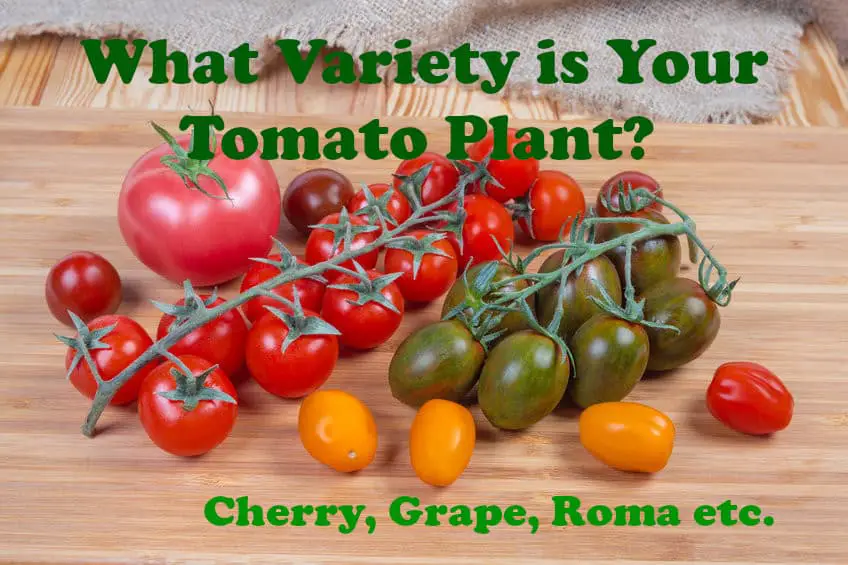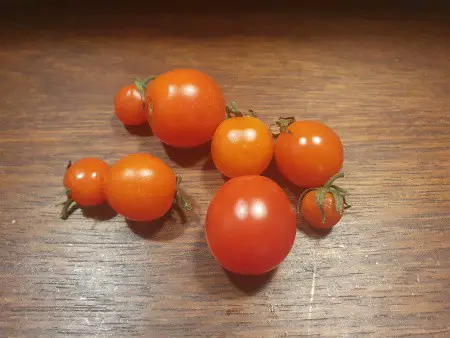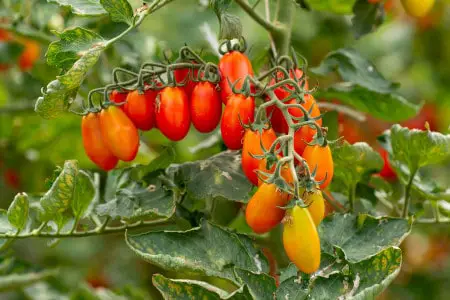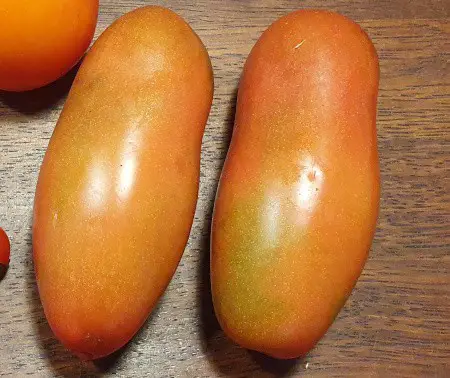
There are thousands of different types of tomato plants, so it can be difficult to know which one you have. After growing tomatoes for several years, I have learned a thing or two about the different types, so I have written this post to help you identify which type you are growing.
To find out what tomato plant you have, there are two things we need to determine.
- Is your tomato plant determinate or indeterminate?
Determinate tomato plants are small and bushy, and indeterminate tomato plants are tall and grow like a vine. Determinate tomato plants grow and produce all their fruit over a relatively short period. Indeterminate tomato plants grow and produce fruit throughout the entire season.
- What variety is your tomato plant?
The easiest way to determine what variety your tomato plant is is to look at the fruit. The most common types of tomatoes are:
- Beefsteak tomatoes – The fruit is large and round.
- Cherry tomatoes – The fruit is small and round.
- Grape tomatoes – The fruit is small, but long and oval shaped
- Roma (plum) tomatoes – The fruit is long and oval-shaped. It is smaller than beefsteak tomatoes but bigger than grape tomatoes,
In this post, I help you find out if your tomato plant is determinate or indeterminate and then if it is a beefsteak, cherry, grape, or roma variety.
Is Your Tomato Plant Determinate or Indeterminate?

The first, and easiest thing you can determine about your tomato plant is whether it is determinate or indeterminate.
Determinate tomato plants are dense and bushy and usually no more than 4 feet (122 cm) tall. Indeterminate tomato varieties are tall, grow like a vine, and can easily grow taller than 6 feet (183 cm). Determinate tomato plants only reach a specific size, and indeterminate tomato plants keep growing until frost comes.
Determinate tomato plants usually stop growing and producing long before frost, but indeterminate tomato plants keep producing as long as they live, but will usually die in the winter.
You can see a good example of a determinate and an indeterminate tomato plant in the photo above.
The plant on the left is determinate and the plant on the right is indeterminate. As you can see, the plant on the left is much smaller, and the branches and leaves are much denser than on the indeterminate tomato plant on the right, which is taller.
- Here is how you can tell if your tomato plant is determinate or indeterminate:
If the branches and leaves on your tomato plant are close together and the plant looks like a dense bush, then it is a determinate variety.
If the branches and leaves on your tomato plant are far apart and the main stem is growing like a vine and continues to grow the whole season, then it is an indeterminate variety.
So basically, if your tomato plant keeps growing throughout the entire season, it is an indeterminate variety. If not, it is a determinate variety.
In my experience, it seems like most people who are growing tomatoes in a garden are growing indeterminate tomatoes, but of course, that does not mean that you are too. Use the tips above to determine what type your plant is.
Since determinate tomato plants don’t get as large as indeterminate ones, they can grow in smaller spaces or smaller pots. You can read more about that on this link.
Below, I explain how you can know if your tomato plant is a cherry tomato, grape tomato, beefsteak tomato, or roma (plum) tomato variety.
What Variety is Your Tomato Plant? Cherry, Grape, Roma etc.

Probably the most reliable way to determine what tomato plant you have is to look at the fruit it is producing.
There is a huge diversity in size, shape, and taste when it comes to tomatoes, so looking at the fruit is an easy way to tell what type of plant you have since they are pretty easy to tell apart.
The four most common types of tomatoes are:
- Cherry tomatoes
- Grape tomatoes
- Beefsteak tomatoes
- Roma (plum) tomatoes
The easiest way to tell which of these four types your tomato plant belongs to is to look at the fruit.
These are the primary differences between the four types of tomatoes:
- Cherry tomato: Round and small (less than 3 inches (7.5 cm) in diameter).
- Grape tomato: Small and long or oval-shaped.
- Beefsteak tomato: Round and large (over 3 inches (7.5 cm) in diameter).
- Roma (plum) tomato: Large and long or oval-shaped.
I have included the names of some of the most common varieties of each type below, where I also go into a bit more detail about each, so you know how to determine which of them your plant belongs to.
Cherry tomatoes
Cherry tomatoes are small and round. They are often super sweet and usually have a high water content, so they are also very juicy. Cherry tomatoes come in many colors, but they are all round and relatively small (usually under 3 inches (7.5 cm) in diameter).

These are some of the most common cherry tomato varieties:
- Supersweet 100
- Sungold
- Golden Sweet
- Tiny Tim
The Sungold cherry tomato is my favorite tomato variety. I have been growing it since I discovered it a few years ago. It is super sweet and juicy, and the color is orange or golden.
Sungold cherry is also one of the varieties that produce the most tomatoes. You can read more about that on this link.
Grape tomatoes
Grape tomatoes are small like cherry tomatoes, but they are longer and more oval-shaped. They generally have lower water content than cherry tomatoes, so they are not as juicy.

These are some of the most common grape tomato varieties:
- Master’s Touch
- Juliet
I have learned that grape tomatoes work really well in salads because the low water content means that they don’t break and squirt juice everywhere when you cut them or mix the salad.
Beefsteak tomatoes
Beefsteak tomatoes are the classic large, round tomatoes. They are bigger than cherry tomatoes, with a diameter of 3 inches (7.5 cm) or more.

These are some of the most common beefsteak tomato varieties:
- Big Beef
- Brandywine
- Cherokee Purple
- Pink Beefsteak
Beefsteak tomatoes taste milder than many other types of tomatoes and they are usually not quite as juicy as cherry tomatoes, so they are perfect for slicing and using in sandwiches or similar.
Roma (plum) tomatoes
Roma tomatoes are also often called plum tomatoes. Their shape is similar to grape tomatoes (long and oval-shaped), but roma tomatoes are larger than both grape and cherry tomatoes.

These are some of the most common roma tomato varieties:
- San Marzano
- Plum Regal
- Granadero
Roma tomato varieties have a lower water content than cherry tomatoes, making them meatier and easier to slice. They are also very popular because they are great for tomato sauce. The San Marzano tomato is one of the most popular and most common varieties to see in stores.
In Conclusion, What Tomato Plant do You Have?
To round off this post and conclude which type of tomato plant you have, I have made a brief resume to help you determine first if your tomato plant is determinate or indeterminate and then if it is a cherry, grape, beefsteak, or roma tomato.
Determinate or indeterminate?
If the branches and leaves on your tomato plant are close together and the plant looks like a bush, then it is a determinate variety.
If the branches and leaves on your tomato plant are far apart and the main stem is growing like a vine and continues to grow the whole season, then it is an indeterminate variety.
Cherry, grape, beefsteak, or roma?
- Cherry tomato: Round and small (less than 3 inches (7.5 cm) in diameter).
- Grape tomato: Small and long or oval-shaped.
- Beefsteak tomato: Round and large (over 3 inches (7.5 cm) in diameter).
- Roma (plum) tomato: Large and long or oval-shaped.
